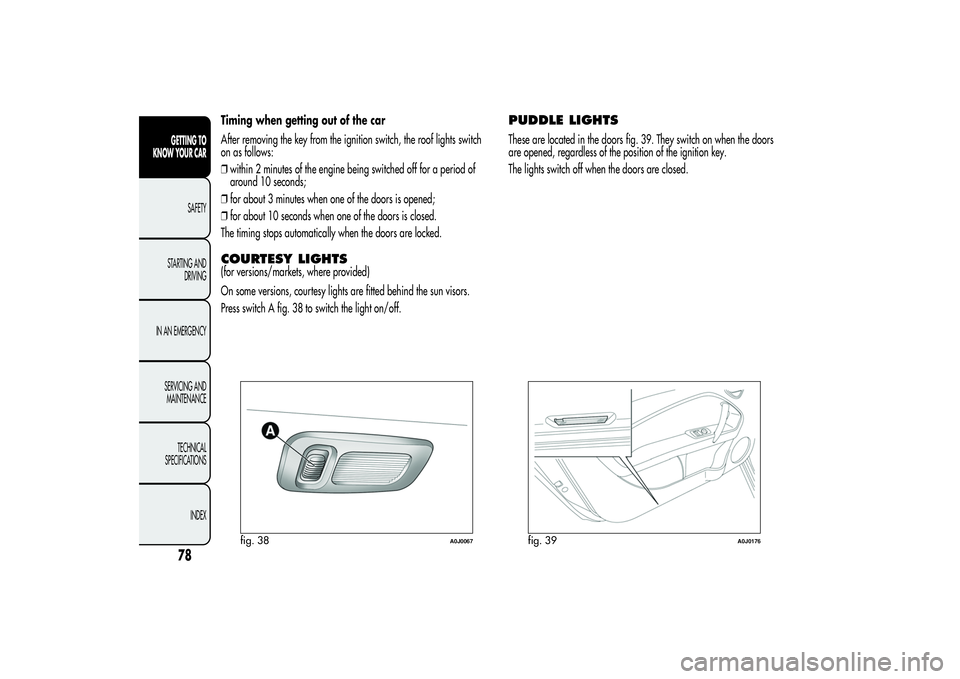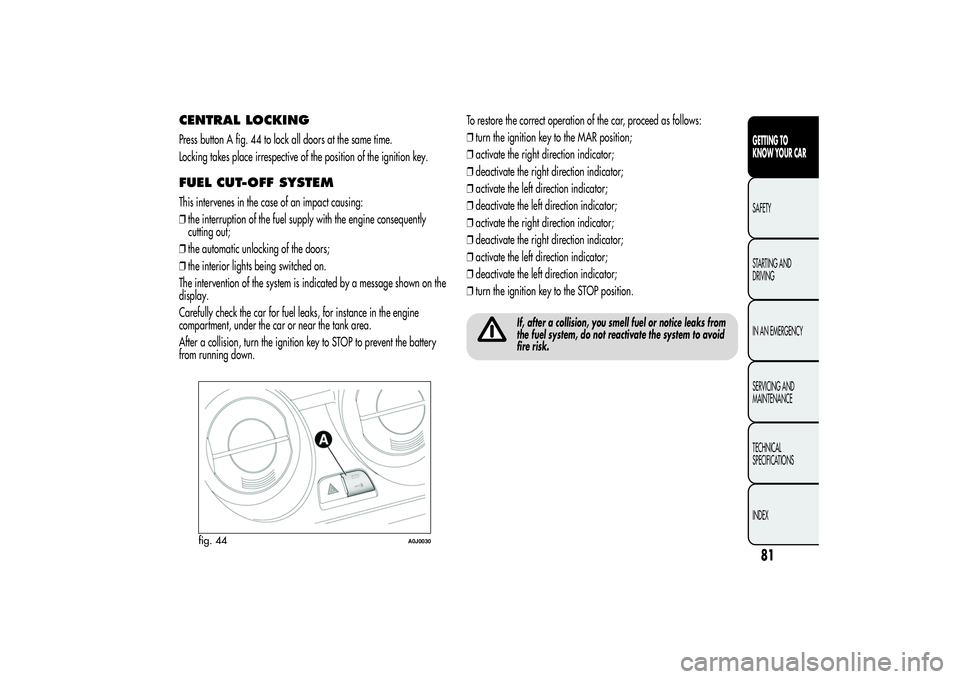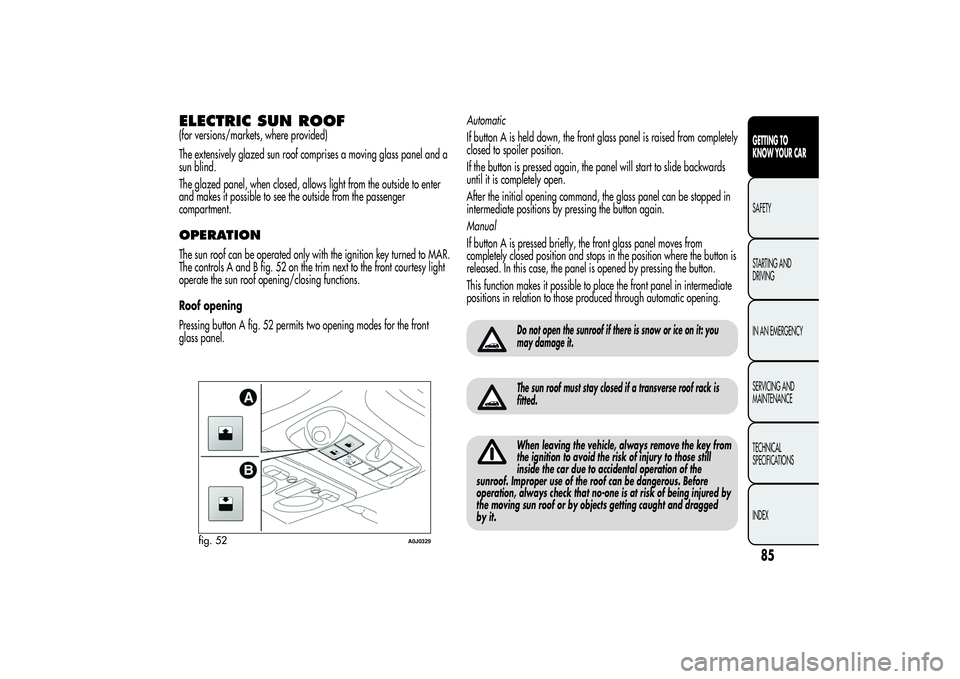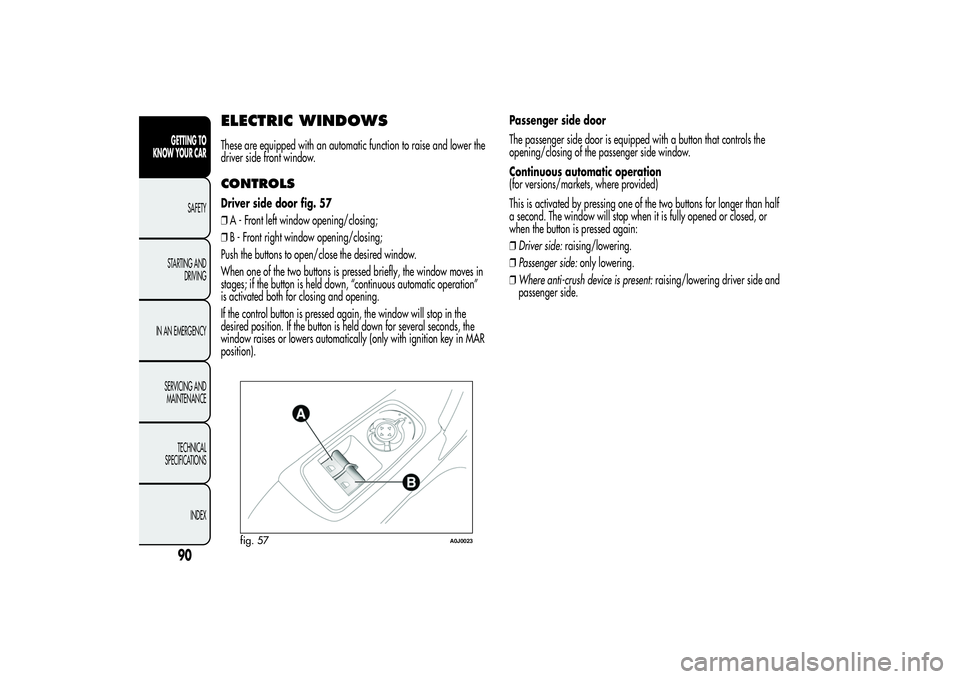stop start Alfa Romeo MiTo 2013 Owner handbook (in English)
[x] Cancel search | Manufacturer: ALFA ROMEO, Model Year: 2013, Model line: MiTo, Model: Alfa Romeo MiTo 2013Pages: 312, PDF Size: 11.5 MB
Page 74 of 312

SIDE LIGHTS/DIPPED BEAM
HEADLIGHTSWith the ignition key turned to MAR, turn ring nut A fig. 33 to
.
The daytime running lights are switched off and the side lights and
dipped headlights are switched on. The warning light
switches
on on the instrument panel.
PARKING LIGHTSThese lights can only be switched on with ignition key at STOP or
removed, by moving ring nut A first to position
and then to position
.
When the parking lights are switched on, the number plate lights and
the front and rear side lights switch on as well (the daytime running
lights (DRLs) remain off however).
The warning light
switches on on the instrument panel.
When the direction indicator stalk is activated the side for the lights
(left or right) can be selected.
AUTOMATIC LIGHTING CONTROL
(AUTOLIGHT) (Dusk sensor)(for versions/markets, where provided)
This infrared LED sensor, combined with the rain sensor and located on
the windscreen, detects the variations in outside brightness depending
on the light sensitivity set with the Set-up Menu: the greater the
sensitivity, the less external light is required to activate the exterior
lights.Activation
The dusk sensor activates when ring nut A fig. 33 is turned to
.In
this way the side lights and dipped headlights are activated
automatically according to the external light level.
IMPORTANT The sensor is unable to detect the presence of fog.
Therefore under these circumstances, these lights must be turned on
manually.
When the lights are turned on by the sensor, the fog lights (for
versions/markets, where provided) and the rear fog lights may be
turned on.
When the lights are automatically switched off, the front and rear fog
lights (if activated) are also switched off. The next time the lights are
switched on automatically, the fog lights must be reactivated manually
(if required).
With the sensor active, it is possible to flash the headlights but the
main beam headlights cannot be switched on. If you need to turn these
lights on, turn ring nut A to position
and turn the dipped
headlights on.
When the lights have been activated automatically and are then
switched off by the sensor, the dipped beam headlights are switched
off first, followed by the side lights a few seconds later.
If the sensor is activated but is malfunctioning, the side lights and
dipped beam headlights are switched on irrespective of the outside
light level and the sensor failure is indicated on the instrument panel
display.
It is also possible to deactivate the sensor and switch on these lights if
necessary.
70GETTING TO
KNOW YOUR CAR
SAFETY
STARTING AND
DRIVING
IN AN EMERGENCY
SERVICING AND
MAINTENANCE
TECHNICAL
SPECIFICATIONS
INDEX
Page 75 of 312

MAIN BEAM HEADLIGHTSWith ring nut A at
pull the stalk towards the steering wheel (stable
position). The warning light
switches on on the instrument panel.
To turn the lights off, pull the stalk towards the steering wheel (dipped
headlights will stay on). It is not possible to switch on the main beam
headlights in fixed mode if the automatic lighting control system is
active.
FLASHINGPull the stalk towards the steering wheel (unstable position) regardless
of the position of ring nut A. The warning light
switches on on
the instrument panel.
DIRECTION INDICATORSBring the stalk into (stable) position:
❒upwards: activates right direction indicator;
❒downwards: activates left direction indicator.
Warning light
or
will flash in the instrument panel.
The indicators are switched off automatically when the steering wheel
is straightened.
"Lane change" function
If you want to signal that you are changing lane, hold the left stalk in
the unstable position for less than half a second. The direction indicator
on the selected side flashes 3 times and then switches off automatically.
"FOLLOW ME HOME" DEVICEThis device allows you to illuminate the area in front of the car for a
certain amount of time.
Activation
With the ignition key at STOP or removed, pull stalk A towards the
steering wheel and move it within 2 minutes of the engine switching
off.
At each single movement of the stalk, the lights will remain on for an
extra 30 seconds up to a maximum of 210 seconds; then the lights are
switched off automatically.
The
warning light on the instrument panel will light up (and the
corresponding message will appear on the display) as long as the
function is active.
The light comes on when the stalk is first moved and stays on until the
function is automatically deactivated. Each movement of the stalk
only increases the amount of time the lights stay on.
Deactivation
Keep stalk A pulled towards the steering wheel for more than 2
seconds.
71GETTING TO
KNOW YOUR CARSAFETY
STARTING AND
DRIVING
IN AN EMERGENCY
SERVICING AND
MAINTENANCE
TECHNICAL
SPECIFICATIONS
INDEX
Page 77 of 312

Move the stalk upwards (unstable position) to limit operation to the
time for which the stalk is held in this position. When released, the
stalk will return to its default position and the wiper will be
automatically stopped.
Do not use the windscreen wiper to remove layers of
snow or ice from the windscreen. In such conditions,
the windscreen wiper may be subjected to excessive
stress and the motor protection, which prevents operation for a
few seconds, may intervene. If operation is not restored, even
after turning the key and restarting the engine, contact Alfa
Romeo Authorized Services.Do not operate the windscreen wiper with the blades
lifted from the windscreen.
"Smart washing" function
Pull the lever towards the steering wheel (unstable position) to operate
the windscreen washer. Keep the stalk pulled for more than half a
second, with just one movement, to operate windscreen washer/wiper
jet at the same time.
The wiper stops working three strokes after the stalk is released. A
further stroke after approximately 6 seconds completes the cycle.
RAIN SENSOR(for versions/markets, where provided)
This is an infra-red LED sensor fitted on the car windscreen fig. 35.
It is able to detect the presence of rain and consequently manage
windscreen wiping in accordance with the amount of water on the
windscreen.
Activation
The sensor is activated when ring nut A fig. 34 is turned to “automatic”
position (“AUTO” control): the windscreen wiper stroke frequency is
thus adjusted in accordance with the amount of water on the
windscreen.
This frequency can vary from no stroke (no rain - windscreen dry) up
to the 2
ndconstant speed operation (heavy rain - windscreen wet).
fig. 35
A0J0189
73GETTING TO
KNOW YOUR CARSAFETY
STARTING AND
DRIVING
IN AN EMERGENCY
SERVICING AND
MAINTENANCE
TECHNICAL
SPECIFICATIONS
INDEX
Page 78 of 312

The sensitivity of the rain sensor can be adjusted through the Set-up
menu (see paragraph “Menu Items” in this section).
If the engine is stopped with the lever in “automatic” position, when it
is next started no wiping cycle will take place even if it is raining.
This prevents accidental activation of the rain sensor when the engine
is started (e.g. when the windscreen is being washed by hand or
the wipers are stuck to the windscreen when there is ice).
Carry out any of the following manoeuvres to restore automatic
operation of the system:
❒movement of left stalk from the automatic position to any other
position and then back to automatic;
❒sensitivity adjustment (by turning ring nut A to increase or decrease).
When the rain sensor is reactivated using any of the manoeuvres
described above, reactivation is indicated by a single stroke of the
windscreen wipers, regardless of the condition of the windscreen.
If the sensitivity is changed whilst the rain sensor is operating, a
windscreen wiper stroke is carried out to confirm the change.
In the event of malfunction of the rain sensor whilst it is active, the
windscreen wiper operates intermittently at a speed consistent with the
sensitivity setting of the rain sensor, regardless of whether there is
rain on the glass (sensor failure is indicated on the display).
The sensor continues to operate and it is possible to set the windscreen
wiper to continuous mode (1
stor 2
ndspeed). The failure indication
remains for as long as the sensor is active.
REAR WINDOW WASHER/WIPER(for versions/markets, where provided)
Activation
This operates only with the ignition key turned to MAR.
Turn ring nut B fig. 34 from positionOto position
to operate the
rear window wiper as follows:
❒in intermittent mode when the windscreen wiper is not operating;
❒in synchronous mode (at half the speed of the windscreen wiper)
when the windscreen wiper is operating;
❒in continuous mode with reverse gear engaged and the control
active.
With reverse gear engaged and windscreen wiper on, the rear
window wiper is activated in continuous mode. Pushing the stalk
towards the dashboard (unstable position) will activate the rear
window washer jet.
Keep the stalk pushed for more than half a second to activate the rear
window wiper as well. Releasing the stalk will activate the smart
washing function, as described for the windscreen wiper.
74GETTING TO
KNOW YOUR CAR
SAFETY
STARTING AND
DRIVING
IN AN EMERGENCY
SERVICING AND
MAINTENANCE
TECHNICAL
SPECIFICATIONS
INDEX
Page 81 of 312

ROOF LIGHTSFRONT ROOF LIGHTSwitch A fig. 37 switches the roof lights on/off.
A switch positions:
❒central position (position 1): lights C and D switch on/off when the
doors are opened/closed.
❒pressed to the left (position 0): lights C and D are always switched
off;
❒pressed to the right (position 2): lights C and D are always switched
on.
Lights switch on/off progressively.B switch positions:
❒central position (position 1): lights C and D are always switched off;
❒pressed to the left (position 0): light C switches on;
❒pressed to the right (position 2): light D switches on.
IMPORTANT Before getting out of the car, make sure that both switches
are in the central position: when the doors are closed the lights will
switch off to avoid draining the battery.
In any case, if the switch is left inadvertently in the permanently on
position, the roof light will turn off automatically 15 minutes after the
engine stopping.
ROOF LIGHT TIMINGOn certain versions, to facilitate getting in/out of the car at night or in
poorly-lit areas, two timed modes have been provided.
Timing when getting into the car
The roof lights switch on according to the following modes:
❒for about 10 seconds when the doors are unlocked;
❒for about 3 minutes when one of the doors is opened;
❒for about 10 seconds when the doors are closed.
The timed period is interrupted when the ignition key is turned to MAR.
fig. 37
A0J0066
77GETTING TO
KNOW YOUR CARSAFETY
STARTING AND
DRIVING
IN AN EMERGENCY
SERVICING AND
MAINTENANCE
TECHNICAL
SPECIFICATIONS
INDEX
Switch B controls the spot light function.
Page 82 of 312

Timing when getting out of the car
After removing the key from the ignition switch, the roof lights switch
on as follows:
❒within 2 minutes of the engine being switched off for a period of
around 10 seconds;
❒for about 3 minutes when one of the doors is opened;
❒for about 10 seconds when one of the doors is closed.
The timing stops automatically when the doors are locked.COURTESY LIGHTS(for versions/markets, where provided)
On some versions, courtesy lights are fitted behind the sun visors.
Press switch A fig. 38 to switch the light on/off.
PUDDLE LIGHTSThese are located in the doors fig. 39. They switch on when the doors
are opened, regardless of the position of the ignition key.
The lights switch off when the doors are closed.
fig. 38
A0J0067
fig. 39
A0J0176
78GETTING TO
KNOW YOUR CAR
SAFETY
STARTING AND
DRIVING
IN AN EMERGENCY
SERVICING AND
MAINTENANCE
TECHNICAL
SPECIFICATIONS
INDEX
Page 85 of 312

CENTRAL LOCKINGPress button A fig. 44 to lock all doors at the same time.
Locking takes place irrespective of the position of the ignition key.FUEL CUT-OFF SYSTEMThis intervenes in the case of an impact causing:
❒the interruption of the fuel supply with the engine consequently
cutting out;
❒the automatic unlocking of the doors;
❒the interior lights being switched on.
The intervention of the system is indicated by a message shown on the
display.
Carefully check the car for fuel leaks, for instance in the engine
compartment, under the car or near the tank area.
After a collision, turn the ignition key to STOP to prevent the battery
from running down.To restore the correct operation of the car, proceed as follows:
❒turn the ignition key to the MAR position;
❒activate the right direction indicator;
❒deactivate the right direction indicator;
❒activate the left direction indicator;
❒deactivate the left direction indicator;
❒activate the right direction indicator;
❒deactivate the right direction indicator;
❒activate the left direction indicator;
❒deactivate the left direction indicator;
❒turn the ignition key to the STOP position.
If, after a collision, you smell fuel or notice leaks from
the fuel system, do not reactivate the system to avoid
fire risk.
fig. 44
A0J0030
81GETTING TO
KNOW YOUR CARSAFETY
STARTING AND
DRIVING
IN AN EMERGENCY
SERVICING AND
MAINTENANCE
TECHNICAL
SPECIFICATIONS
INDEX
Page 89 of 312

ELECTRIC SUN ROOF(for versions/markets, where provided)
The extensively glazed sun roof comprises a moving glass panel and a
sun blind.
The glazed panel, when closed, allows light from the outside to enter
and makes it possible to see the outside from the passenger
compartment.OPERATIONThe sun roof can be operated only with the ignition key turned to MAR.
The controls A and B fig. 52 on the trim next to the front courtesy light
operate the sun roof opening/closing functions.
Roof opening
Pressing button A fig. 52 permits two opening modes for the front
glass panel.Automatic
If button A is held down, the front glass panel is raised from completely
closed to spoiler position.
If the button is pressed again, the panel will start to slide backwards
until it is completely open.
After the initial opening command, the glass panel can be stopped in
intermediate positions by pressing the button again.
Manual
If button A is pressed briefly, the front glass panel moves from
completely closed position and stops in the position where the button is
released. In this case, the panel is opened by pressing the button.
This function makes it possible to place the front panel in intermediate
positions in relation to those produced through automatic opening.
Do not open the sunroof if there is snow or ice on it: you
may damage it.The sun roof must stay closed if a transverse roof rack is
fitted.When leaving the vehicle, always remove the key from
the ignition to avoid the risk of injury to those still
inside the car due to accidental operation of the
sunroof. Improper use of the roof can be dangerous. Before
operation, always check that no-one is at risk of being injured by
the moving sun roof or by objects getting caught and dragged
by it.
fig. 52
A0J0329
85GETTING TO
KNOW YOUR CARSAFETY
STARTING AND
DRIVING
IN AN EMERGENCY
SERVICING AND
MAINTENANCE
TECHNICAL
SPECIFICATIONS
INDEX
Page 90 of 312

Closing the sun roof
Pressing button B fig. 52 permits two closing modes for the front glass
panel.
Automatic
With roof completely open, hold down button B: the front glass panel
will move to spoiler position.
If the button is pressed again, the panel will start to slide forward until
it is completely closed.
After the initial opening command, the glass panel can be stopped in
intermediate positions by pressing the button again.
Manual
If button B is pressed briefly, the front glass panel moves from the
completely open position and stops in the position where the button is
released. In this case, the panel is closed by pressing the button.
This function makes it possible to place the front glass panel in
intermediate positions in relation to those produced through automatic
closing.SUN BLINDThe brightness in the passenger compartment can be adjusted by using
a sun blind.
Opening the blind:press button A fig. 53 to release the blind and
then grip handle B in order to slide it backwards.
Closing the blind:grip handle B fig. 53 and slide the blind
forwards, making sure that it clicks into place.
ROOF CLOSING SAFETY DEVICES
(anti-pinch function)The anti-pinch system, which conforms to Directive 2000/4/EC, is
active during the horizontal and vertical closing stage of the panel
after an obstacle is encountered (e.g. finger, hand):
❒during horizontal closing movementit is active for the
entire travel and, after an obstacle is encountered at the front of the
glass panel, it reverses the movement;
❒during vertical closing movementit is active and, after an
obstacle is encountered at the back of the glass panel, it reverses
the movement until the spoiler position is reached.
The possibility of pinching from the inside of the passenger
compartment in the side areas of the panel is avoided through the
adoption of side guards that prevent access to risk areas.
IMPORTANT The anti-pinch system is deactivated by pressing button B
continuously.
fig. 53
A0J0157
86GETTING TO
KNOW YOUR CAR
SAFETY
STARTING AND
DRIVING
IN AN EMERGENCY
SERVICING AND
MAINTENANCE
TECHNICAL
SPECIFICATIONS
INDEX
Page 94 of 312

Passenger side door
The passenger side door is equipped with a button that controls the
opening/closing of the passenger side window.
Continuous automatic operation
(for versions/markets, where provided)
This is activated by pressing one of the two buttons for longer than half
a second. The window will stop when it is fully opened or closed, or
when the button is pressed again:
❒Driver side:raising/lowering.
❒Passenger side:only lowering.
❒Where anti-crush device is present:raising/lowering driver side and
passenger side.
90GETTING TO
KNOW YOUR CAR
SAFETY
STARTING AND
DRIVING
IN AN EMERGENCY
SERVICING AND
MAINTENANCE
TECHNICAL
SPECIFICATIONS
INDEX
ELECTRIC WINDOWSThese are equipped with an automatic function to raise and lower the
driver side front window.CONTROLSDriver side door fig. 57
❒A - Front left window opening/closing;
❒B - Front right window opening/closing;
Push the buttons to open/close the desired window.
When one of the two buttons is pressed briefly, the window moves in
stages; if the button is held down, “continuous automatic operation”
is activated both for closing and opening.
If the control button is pressed again, the window will stop in the
desired position. If the button is held down for several seconds, the
window raises or lowers automatically (only with ignition key in MAR
position).
fig. 57
A0J0023